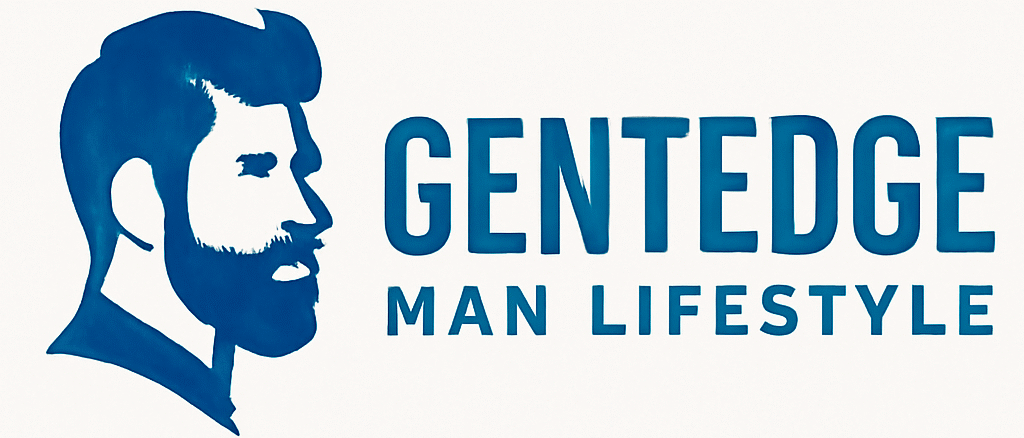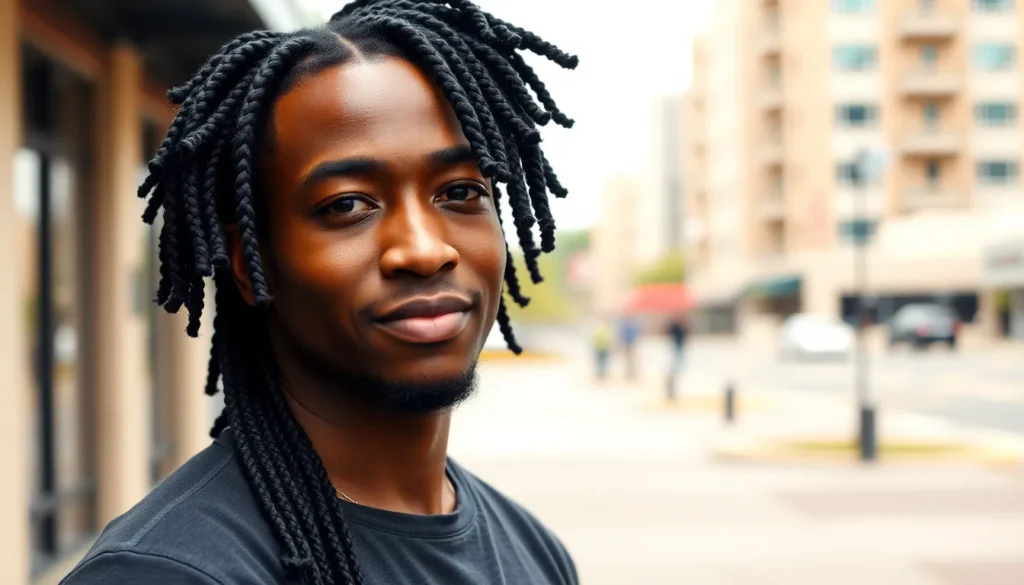We’ve all seen how braids can completely transform a man’s look – from boardroom professional to weekend warrior. For Black men blessed with natural hair texture that holds braids beautifully, the styling possibilities are truly endless. Whether you’re looking to protect your hair while it grows or simply want a fresh new aesthetic, braids offer the perfect solution.
The industry of men’s braiding has exploded with creative options that go far beyond basic cornrows. We’re talking about intricate patterns, modern twists on classic styles, and protective techniques that’ll keep your hair healthy while you look incredible. From subtle geometric designs that work in corporate settings to bold artistic statements that showcase your personality, there’s a braided style waiting for every man.
Ready to discover which braided look will become your signature style? We’ll walk you through the most popular options, maintenance tips, and everything you need to know about rocking braids with confidence.
Classic Three-Strand Braids for Everyday Style
Classic three-strand braids offer the perfect foundation for men entering the industry of braided hairstyles. These timeless techniques provide versatility and simplicity that work with various hair lengths and textures.
Simple Side Braids
Side braids create an asymmetrical look that adds visual interest without overwhelming your overall style. We recommend starting with damp hair and a small amount of leave-in conditioner to ensure smooth braiding. Position the braid along your natural part or create a deep side part for maximum impact.
Single side braids work exceptionally well for professional settings where you want subtle texture. The placement draws attention to your facial features while maintaining a polished appearance. You can secure the end with a small clear elastic or decorative hair tie depending on your preference.
Multiple side braids offer more texture and personality for casual occasions. Space them evenly across one side of your head, leaving the other side with loose hair or a fade. This style works particularly well with medium to long hair lengths and can be completed in under 30 minutes.
Traditional Back Braids
Back braids represent the most classic approach to three-strand braiding for men. We suggest sectioning your hair into equal parts before beginning, as this ensures consistent braid thickness and a balanced final look. Start each braid at the crown and work your way down to the nape of your neck.
Single back braids suit men with longer hair who prefer a streamlined, minimalist aesthetic. The braid runs straight down the center of your head, creating a clean line that works with both casual and formal attire. This style typically lasts 3-5 days with proper nighttime protection.
Double back braids provide more texture while maintaining the traditional feel. Position them parallel to each other, spacing them about 2-3 inches apart. This variation adds visual dimension and works especially well for men with thick, coarse hair textures that can support multiple braids.
Accent Braids for Short Hair
Accent braids prove that shorter hair lengths don’t limit your braiding options. We focus on creating small, strategic braids that enhance your existing style rather than dominating it. These mini braids typically measure 2-4 inches in length and serve as decorative elements.
Temple braids frame your face beautifully and work with most short hairstyles. Create thin braids along your hairline, incorporating them into fades or tapered cuts. These accent pieces add sophistication to simple styles and can be refreshed weekly without affecting the rest of your haircut.
Crown accent braids add texture to the top section of short hair. Braid small sections randomly throughout the crown area, leaving most of your hair unbraided. This technique creates visual interest and works particularly well with twist-outs or wash-and-go styles underneath.
French Braids That Add Sophisticated Texture
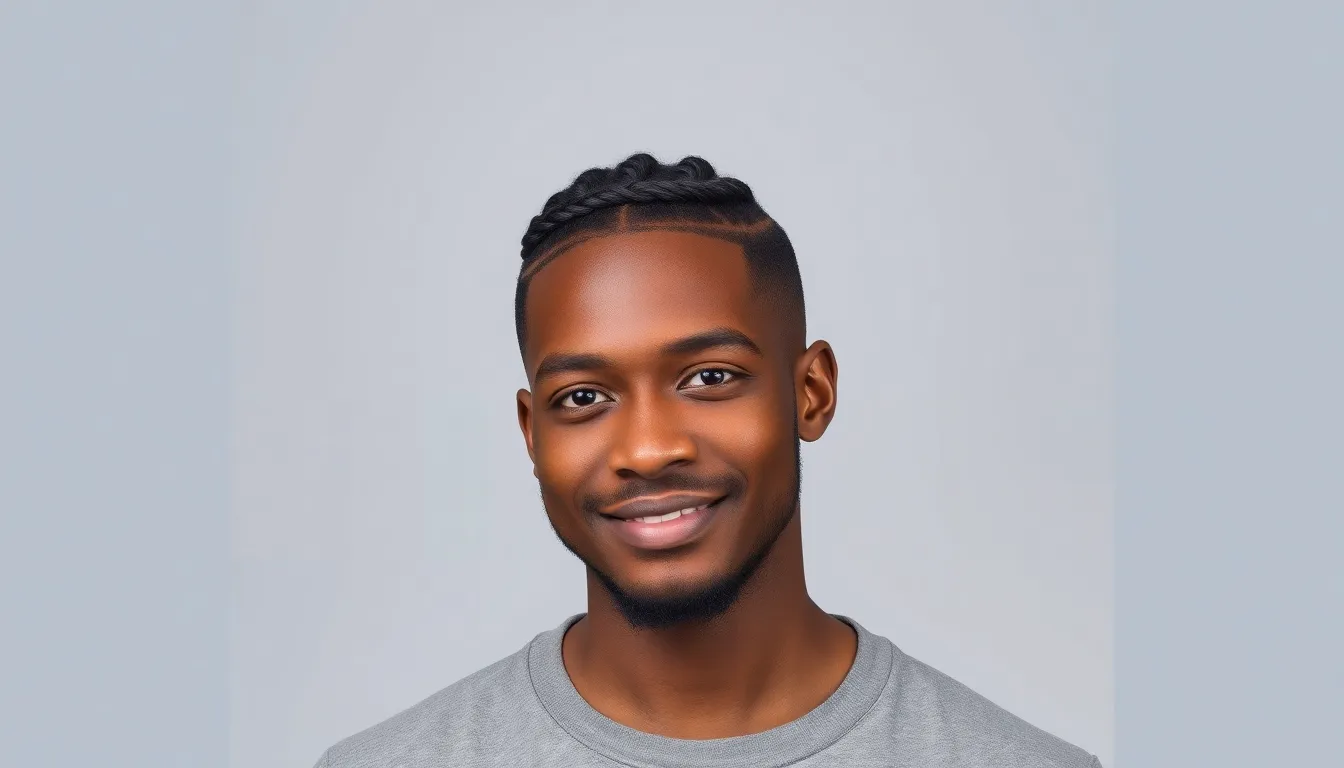
French braids on Black men’s hair create a polished, textured look by weaving strands tightly against the scalp. This technique highlights the natural curl pattern while adding sophistication and neatness to your overall appearance.
Single French Braid Down the Center
Creating a central French braid establishes a classic, symmetrical style that runs straight down the middle of your head. This prominent braid emphasizes structure and balance while drawing attention to your natural hair texture. We recommend combining this look with fades or tapered sides to create striking contrast between the intricate braided top and clean sides.
Adjusting braid thickness allows you to customize the impact of your central French braid based on your hair length and personal style preferences. Thicker braids create a bold, statement look that works well for longer hair lengths. Thinner variations offer a more subtle approach that complements shorter hair while still maintaining the sophisticated texture French braids provide.
Blow drying your hair to its maximum length before braiding helps ease the braiding process and results in cleaner, more defined braids. This preparation step ensures your French braid maintains its structured appearance throughout the day.
Multiple French Braids for Fuller Looks
Arranging multiple French braids in parallel rows creates volume and a fuller hairstyle that distributes hair evenly for a balanced appearance. This technique works particularly well for men with thick, dense hair who want to showcase their natural texture while maintaining control and organization.
Combining patterns with multiple braids enhances visual texture and adds uniqueness to your overall style. Brick wave designs integrated with your French braids create complex, eye-catching patterns that set your look apart from traditional single braid styles.
Spacing your braids evenly ensures a professional, well-planned appearance that showcases the sophistication of French braiding techniques. We suggest maintaining consistent spacing between each braid to achieve the cleanest, most polished final result.
French Braid Fade Combinations
Pairing French braids with fade haircuts creates a modern twist that merges intricate braided texture with sharp, clean fades on the sides or back. This combination has become a popular contemporary trend that keeps your overall style fresh while making the braids the focal point of your look.
Contrasting braided tops with faded sides creates visual interest and highlights the craftsmanship of your French braids. The sharp transition between textured braids and smooth fades adds dimension to your hairstyle while maintaining a neat, professional appearance.
Using castor oil and styling products helps manage frizz and maintains the neatness of your French braids throughout the day. These products work particularly well with fade combinations, ensuring both your braids and faded sections look their best.
Dutch Braids for Bold Statement Looks

Dutch braids create an eye-catching three-dimensional effect that sits prominently on top of your hair, making them perfect for Black men who want their hairstyle to make a powerful impression. This reverse braiding technique produces a raised, sculptural appearance that emphasizes natural hair texture and volume.
Reverse Dutch Braid Techniques
Weaving strands underneath instead of over creates the signature raised effect that makes Dutch braids so distinctive. Start by sectioning your hair and crossing each new strand under the existing braid rather than over it, which causes the braid to pop outward from your scalp.
Type 4 hair responds exceptionally well to this technique because its coily, tightly packed texture holds the reverse weave securely in place. Apply castor oil before braiding to manage tension and prevent breakage while maintaining the braid’s structure.
Laydown lacquer helps keep the braids neat without causing frizz or damaging your hair’s natural curl pattern. Work the product through small sections as you braid, ensuring each strand lies smoothly against the scalp before incorporating it into the pattern.
Double Dutch Braids
Two parallel Dutch braids running from forehead to nape create a clean, symmetrical look that works perfectly for both casual and formal occasions. Position each braid about two inches from your part line, maintaining equal spacing for a balanced appearance.
Medium-length hair provides the ideal canvas for double Dutch braids because there’s enough length to create substantial braids without overwhelming your face shape. Keep the braids tight at the roots and allow them to relax slightly toward the ends for a natural finish.
Combining double Dutch braids with fade or undercut sides adds a modern edge to this classic style. The contrast between the textured braids on top and the clean sides creates visual interest while highlighting the intricate braid work.
Dutch Braid Undercut Styles
Pairing Dutch braids with closely trimmed or shaved sides creates a sharp contrast that emphasizes the three-dimensional quality of the braids. Focus the braiding on the crown and top sections while keeping the sides at a #1 or #2 guard length.
The undercut highlights the braids by removing competing visual elements from the sides and back of your head. This technique draws attention upward to the intricate braid patterns while maintaining a clean, professional appearance.
Gradient fades work particularly well with Dutch braid undercuts because they provide a smooth transition from the braided top to the trimmed sides. Ask your barber to blend the fade seamlessly into the braided sections for a polished, cohesive look.
Box Braids for Long-Lasting Protection
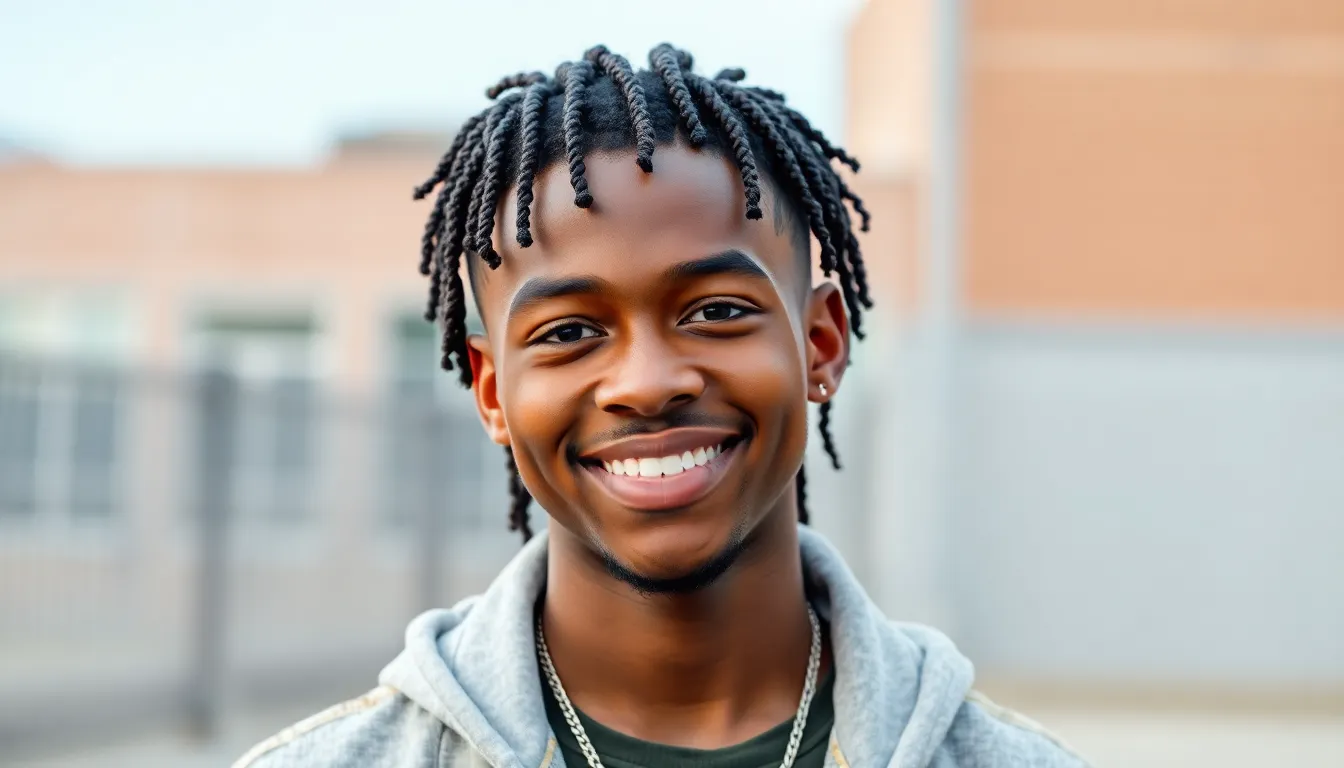
Box braids shield your natural hair from environmental damage while reducing daily manipulation that causes breakage. We’ve seen how these protective styles promote healthier hair retention and growth, making them ideal for Black men who want to maintain length and strength.
Medium-Sized Box Braids
Medium-sized box braids offer the perfect balance between style versatility and manageability for everyday wear. These braids work well with different hair textures and provide enough thickness for intricate styling without becoming overwhelming. We recommend this size for men seeking a protective style that’s both practical and visually appealing.
The installation process takes moderate time compared to smaller braids, making them accessible for most budgets. Medium box braids allow you to experiment with colors, lengths, and accessories while maintaining that distinctive geometric appearance from their square-shaped sections. They’re particularly effective when combined with fades or undercuts for a modern, edgy contrast.
Maintenance becomes straightforward once these braids are properly installed. You’ll need to moisturize regularly and avoid excessive tension to prevent breakage, but the daily upkeep remains minimal compared to loose natural hair styles.
Jumbo Box Braids for Quick Installation
Jumbo box braids deliver bold visual impact with significantly faster installation times than smaller alternatives. These thicker, wider braids work exceptionally well for men with longer hair who want to make a strong style statement. We’ve found that the heavy, defined look of jumbo braids creates an unmistakable presence.
The installation process requires fewer sections, which translates to shorter appointment times and often lower costs. Jumbo braids showcase the protective benefits of braiding while offering that dramatic aesthetic many men desire. They work particularly well for those who prefer low maintenance styles with maximum visual effect.
Styling options remain diverse even though the larger size. You can still incorporate colors, vary lengths, and add accessories to personalize your look. The substantial thickness of jumbo braids makes them ideal for men who want their hairstyle to serve as a focal point of their overall appearance.
Micro Box Braids for Detailed Styling
Micro box braids require skilled braiders due to their intricate nature involving many tiny, precisely created sections. These small braids offer the most refined and detailed appearance among box braid variations. We’ve observed that micro braids provide exceptional versatility for men who appreciate subtle sophistication.
The installation demands longer hair and considerably more time than larger braid sizes. But, the results deliver unmatched precision and styling flexibility. Micro braids pair beautifully with fades, creating striking contrast between the detailed braid work and clean, short sides.
These braids excel in professional settings where you need a polished appearance that still celebrates natural hair texture. The neat, uniform sections create visual interest without overwhelming your overall look. Micro box braids also offer the longest lasting protection since the smaller size distributes tension more evenly across your scalp.
Cornrow Braids for Clean Geometric Patterns
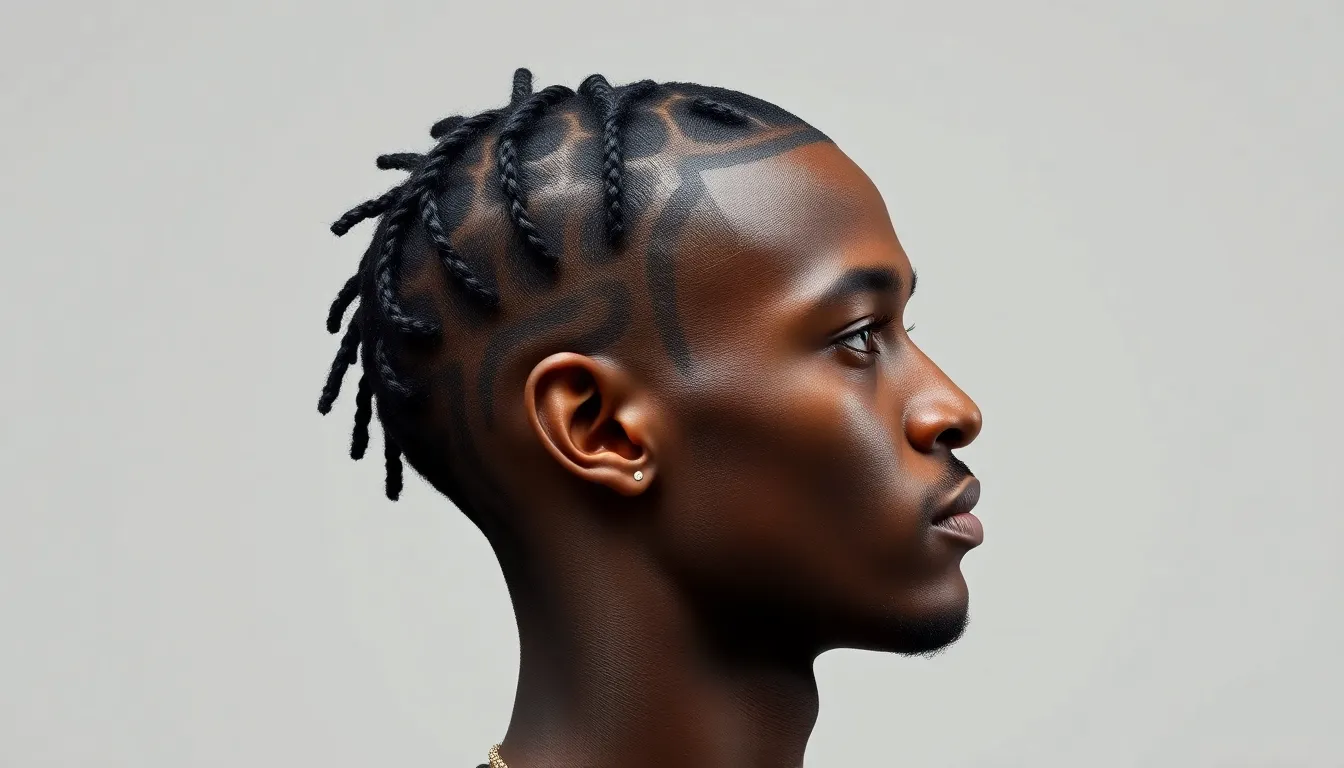
Geometric cornrow patterns transform your scalp into an artistic canvas using precise lines and mathematical shapes. Professional barbers create these striking visual effects through careful planning and expert braiding techniques.
Straight Back Cornrows
Classic straight back cornrows remain the foundation of geometric cornrow artistry for Black men. These timeless styles involve braiding hair directly from the forehead to the nape, creating perfectly parallel lines across your scalp. Athletes particularly favor this practical design because it keeps hair securely in place during physical activities.
Size variations allow you to customize the look according to your personal preference. Smaller braids create a more detailed appearance with increased line density, while larger braids offer a bolder statement with fewer rows. Maintenance becomes simpler with straight back cornrows since the uniform pattern makes touch ups easier to execute.
Duration typically ranges from 2 to 4 weeks when properly maintained with regular scalp moisturizing and gentle cleansing routines.
Curved and Zigzag Cornrow Designs
Ever-changing curved patterns break away from traditional straight lines to create flowing, artistic movements across your scalp. These designs follow your natural hairline contours or create deliberate contrasts that catch the eye from multiple angles. Skilled braiders can create spirals, waves, and organic shapes that showcase advanced technical abilities.
Zigzag cornrows add playful energy to your hairstyle through sharp directional changes and angular patterns. Popular variations include lightning bolt designs, chevron patterns, and interlocking geometric shapes that create optical illusions. Creative combinations often incorporate both curved and straight elements within the same design.
Planning becomes crucial for complex geometric patterns since mistakes require complete rebraiding of affected sections. Professional consultation ensures your chosen design complements your head shape and hair density.
Cornrow Fade Combinations
Modern cornrow fade combinations blend traditional braiding with contemporary barbering techniques for a sharp, dimensional look. Fades on the sides and back emphasize the cornrow patterns on top while creating clean transitions between braided and cut sections. Low fades offer subtle contrast, while high fades create dramatic emphasis on the cornrow designs.
Versatility increases significantly when longer cornrows can be styled into ponytails or top knots for different occasions. Temple fades specifically highlight intricate cornrow patterns around the hairline while maintaining length throughout the crown area. Mid fades provide balanced proportions that work well with both simple and complex geometric designs.
Maintenance schedules require coordination between cornrow touch ups every 3 to 4 weeks and fade refreshments every 1 to 2 weeks for optimal appearance.
Two-Strand Twists for Low-Maintenance Options
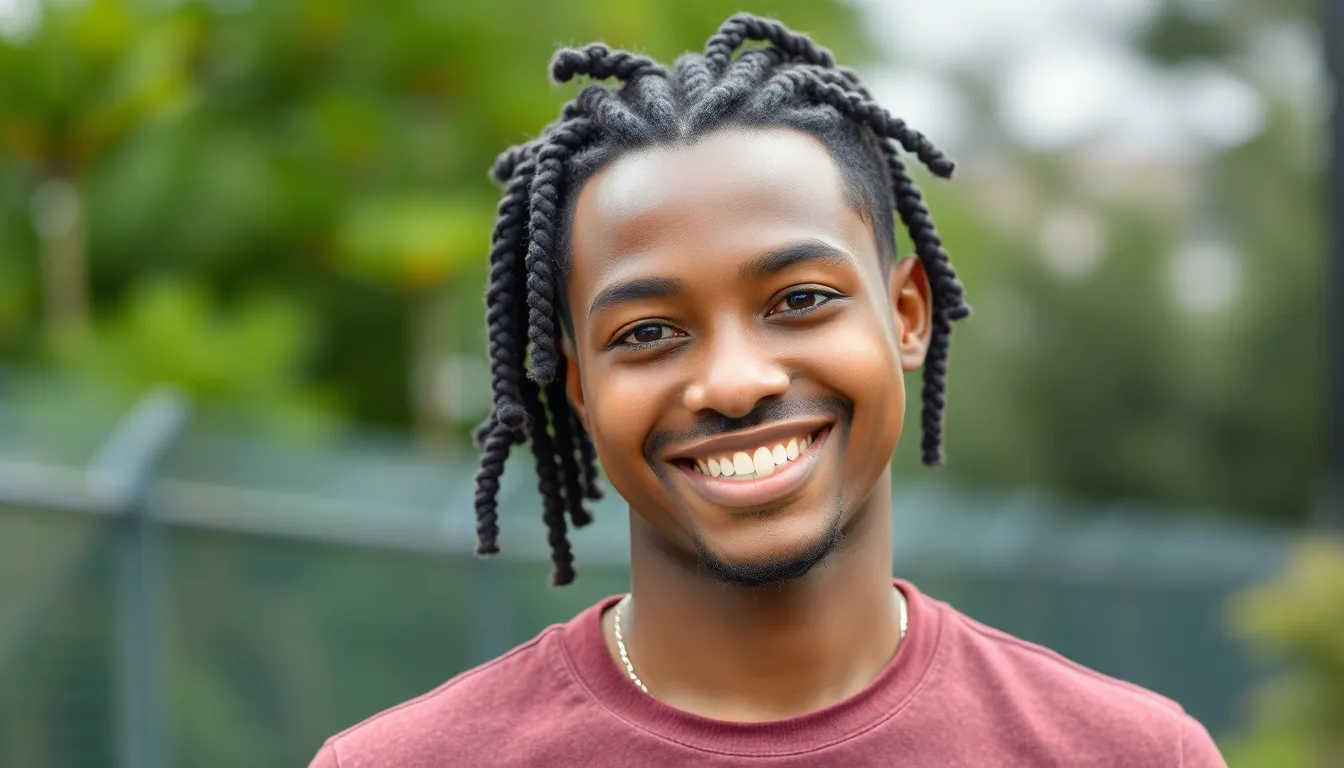
Two-strand twists offer one of the most practical braiding alternatives for Black men seeking protective styling without daily commitment. This technique involves dividing hair into sections and twisting two strands around each other from root to tip, helping retain moisture while reducing breakage and promoting natural hair growth.
Finger Twist Techniques
Finger twists create natural-looking texture using only your hands rather than combs or styling tools. This method involves twisting small sections of hair tightly with your fingers, producing a casual and easily maintained appearance. Short to medium-length hair works best for finger twists, making them ideal for men who prefer a relaxed styling approach.
Creative variations emerge naturally when using finger twist techniques. Different section sizes produce varied textures, from tight coils to looser waves. We recommend starting with damp hair and applying a light leave-in conditioner to enhance the twisting process and final results.
Rope Twist Variations
Rope twists provide superior durability compared to standard two-strand methods through their unique construction technique. First, twist two strands in the same direction, then twist them together in the opposite direction to create a rope-like appearance that maintains its shape longer. This method produces more defined results that resist unraveling throughout daily activities.
Size variations allow for different aesthetic outcomes with rope twists. Thicker rope twists make bold statements and work well for special occasions, while thinner versions offer subtle texture for professional environments. Combining rope twists with fade cuts creates striking contrast between the detailed twists and clean sides.
Twist-Out Results and Styling
Twist-out styles emerge after unraveling completed twists, revealing defined curls with enhanced volume and movement. This versatile finish adds natural texture and fullness to your hair, creating styling opportunities like frohawks or textured wash-and-go looks. Moisturizing products and light oils help maintain the twist-out’s definition while adding healthy shine.
Strategic styling transforms basic twist-outs into sophisticated looks suitable for various occasions. Combining twist-out sections with other braided elements creates unique hybrid styles that showcase your creativity. The texture achieved through twist-outs also serves as an excellent foundation for updos or half-up styles when you need versatile options for different settings.
Fishtail Braids for Unique Textural Appeal
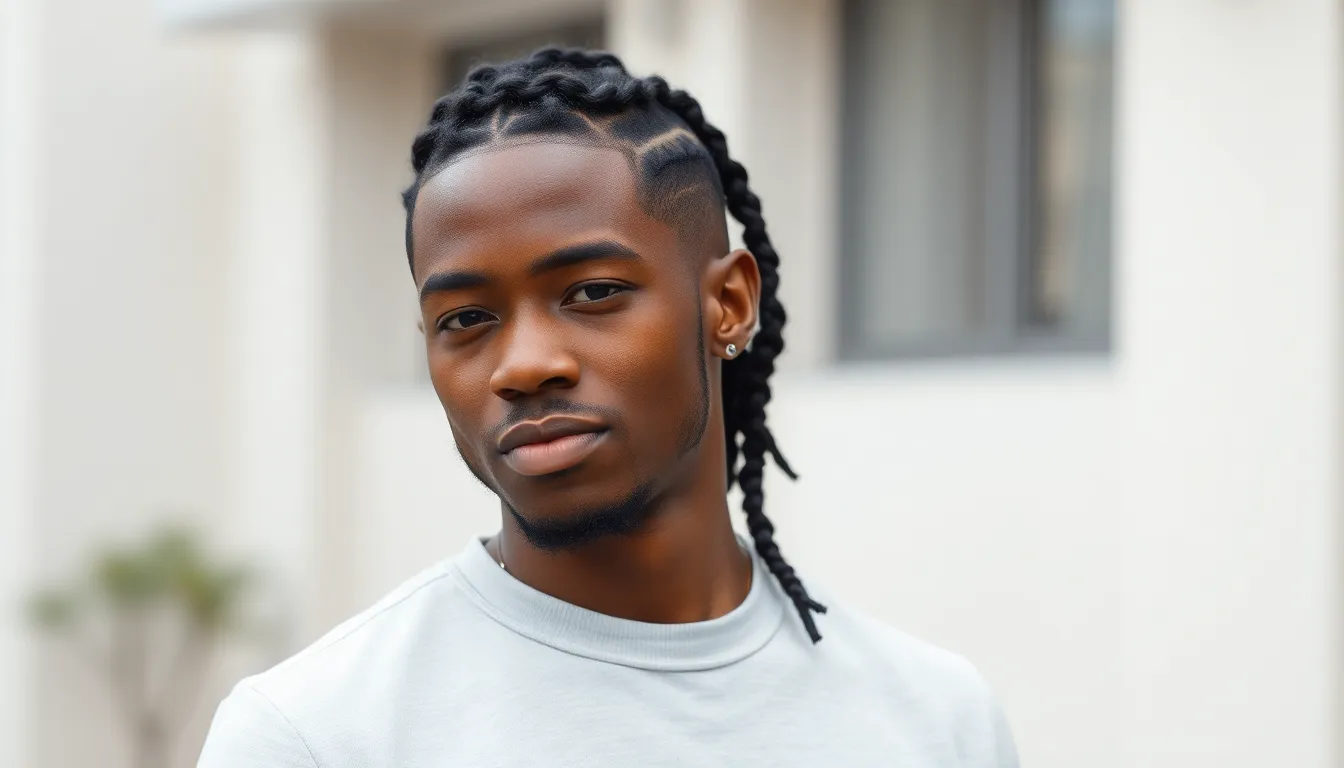
Fishtail braids offer Black men a sophisticated alternative to traditional braiding styles, highlighting the natural curl pattern and thickness of type 4 hair. This intricate technique creates a visually striking, scaled effect that stands out from typical box braids or cornrows.
Basic Fishtail Braid Method
Fishtail braids require dividing your hair into two large sections instead of the traditional three-strand approach. We alternate crossing small strands from each side, creating a woven pattern that resembles fish scales. Type 4 hair textures work exceptionally well with this technique because the natural thickness adds volume and definition to the braid structure.
Starting with clean, slightly damp hair makes the braiding process smoother and helps control frizz. You’ll need to practice the alternating pattern to achieve neat, consistent results across the entire braid length. Products like leave-in conditioners or light oils can help maintain definition throughout the braiding process.
Short to medium-length natural hair provides the ideal canvas for fishtail braids, though the technique adapts well to various hair lengths. Mastering the crossing motion takes time, but the distinctive textured appearance makes the effort worthwhile for men seeking unique styling options.
Side-Swept Fishtail Styles
Side-swept fishtail braids create an asymmetrical look that works perfectly for both casual and formal occasions. We recommend starting the braid from a deep side part, allowing the fishtail to cascade naturally across one side of your head. Pairing this style with faded or tapered sides enhances the modern appeal while keeping the focus on the intricate braid work.
Positioning the braid sweep requires careful consideration of your face shape and personal style preferences. Men with angular features often find that side-swept braids soften their overall appearance, while those with rounder faces benefit from the added structure and definition.
Professional settings welcome this sophisticated variation because it maintains a polished appearance while showcasing creative braiding skills. You can adjust the tightness of the braid to suit different occasions, with looser versions offering more casual appeal and tighter braids providing formal elegance.
Messy Fishtail for Casual Looks
Messy fishtail braids embrace the natural texture and volume of Black hair, creating an effortlessly rugged appearance. We intentionally allow some strands to loosen and create strategic frizz that enhances the braid’s organic appeal. This approach works particularly well for everyday wear and outdoor activities where a perfectly polished look isn’t necessary.
Achieving the right amount of “messiness” requires a delicate balance between control and freedom. Start with a standard fishtail technique, then gently tug at sections to create volume and texture while maintaining the overall braid structure. Castor oil applied to the scalp helps maintain hair health and adds natural shine to the loosened strands.
Weekend styling becomes effortless with messy fishtail braids because they require minimal maintenance once installed. You can refresh the look by lightly misting with water and scrunching the braid to reactivate the natural curl pattern, keeping the style looking intentionally undone rather than neglected.
Maintenance Tips for Healthy Braided Hair

Proper braid maintenance ensures your protective style enhances rather than damages your natural hair. We’ll guide you through essential care techniques that keep your braids looking fresh and your scalp healthy.
Proper Washing Techniques
Washing frequency should remain limited to once weekly maximum to prevent scalp irritation and root tension. Excessive washing can cause frizz and weaken the braid structure, particularly with type 4 hair textures.
Apply shampoo using gentle tapping or massaging motions instead of aggressive rubbing. We recommend focusing the lather around your scalp and braid bases, allowing the suds to cleanse without disturbing the intricate patterns you’ve worked hard to create.
Rinse thoroughly with lukewarm water to remove all product residue. Cold water helps seal the hair cuticles, while hot water can cause unnecessary dryness and frizz formation.
Dry your braids by gently squeezing out excess water with a microfiber towel. Avoid rubbing or pulling, which can create frizz and potentially loosen your carefully crafted braids.
| Washing Frequency | Technique | Water Temperature | Drying Method |
|---|---|---|---|
| Once weekly maximum | Gentle tapping/massaging | Lukewarm for washing, cool for rinsing | Squeeze with microfiber towel |
Moisturizing and Scalp Care
Daily moisturizing becomes essential since Afro textured hair naturally lacks moisture and tends toward brittleness. We suggest using lightweight oils like jojoba or argan oil to penetrate the hair shaft without creating heavy buildup.
Scalp care requires consistent attention to prevent dryness and irritation that can damage hair follicles. Focus on keeping your scalp clean and hydrated using products specifically designed for braided styles.
Protect your investment during sleep by using satin or silk pillowcases and hair wraps. These materials minimize friction and moisture loss that cotton fabrics typically cause.
Avoid scratching your scalp when it feels itchy, as this can damage follicles and create inflammation. Instead, use a spray bottle with diluted leave in conditioner to provide relief and hydration.
When to Remove and Refresh Braids
Remove braids around the 6 week mark before they cause excessive tension or scalp damage. Individual hair types and care routines may require earlier removal, so pay attention to your scalp’s signals.
Watch for warning signs including increased tension, persistent scalp irritation, or visible matting around the roots. These indicators suggest your braids have exceeded their healthy lifespan and need immediate attention.
Schedule regular touch ups every 2 to 3 weeks to maintain neat edges and prevent premature loosening. Professional maintenance extends the life of your braids while keeping them looking fresh and defined.
Allow your natural hair to rest between braiding sessions by waiting at least one week before reinstalling. This recovery period lets your scalp breathe and prevents the cumulative damage that continuous braiding can cause.
Conclusion
Braids offer Black men an incredible opportunity to express their personal style while protecting their natural hair. From the versatility of box braids to the sophisticated appeal of fishtail designs we’ve explored countless options that cater to every lifestyle and preference.
The key to successful braiding lies in understanding your hair type choosing the right style for your needs and maintaining proper care routines. Whether you’re drawn to the bold statement of Dutch braids or the refined elegance of micro box braids there’s a perfect option waiting for you.
Remember that healthy braided hair starts with gentle maintenance daily moisturizing and knowing when to give your natural hair a break. With the right approach braids become more than just a hairstyle—they’re a celebration of your heritage and a pathway to healthier stronger hair.
Frequently Asked Questions
What are the best braids for Black men with natural hair?
Box braids, cornrows, and two-strand twists are excellent choices for Black men with natural hair. These styles provide protective benefits while accommodating Type 4 hair texture. Box braids offer versatility and long-lasting protection, cornrows create clean geometric patterns, and two-strand twists require minimal maintenance while promoting hair growth and moisture retention.
How long do braids typically last for men?
Most men’s braids last 4-8 weeks depending on the style and maintenance routine. Box braids can last up to 8 weeks, cornrows typically last 2-4 weeks, and two-strand twists last 3-6 weeks. Proper care, including regular moisturizing and gentle washing, can extend the lifespan of your braids significantly.
Can men with short hair get braids?
Yes, men with short hair can get braids through accent braiding, small cornrows, or two-strand twists. Hair should be at least 2-3 inches long for most braiding styles. Shorter hair works well for finger twists, small box braids, or decorative cornrow patterns that complement fades or tapered cuts.
How often should I wash my braids?
Wash braided hair once per week using gentle techniques. Focus on cleansing the scalp rather than manipulating the braids themselves. Use diluted shampoo or co-washing products, and avoid excessive scrubbing. After washing, ensure braids are completely dry to prevent mold, mildew, or scalp irritation.
What’s the difference between Dutch braids and French braids?
French braids weave hair under each strand, lying flat against the scalp, while Dutch braids weave hair over each strand, creating a raised, three-dimensional effect. Dutch braids appear more prominent and bold, making them ideal for men seeking eye-catching styles. Both work well with fade combinations.
How do I maintain healthy hair while wearing braids?
Moisturize daily with lightweight oils like jojoba or argan oil, focusing on the scalp and exposed hair. Sleep with a silk or satin pillowcase, avoid scratching your scalp, and don’t leave braids in too long. Allow your natural hair to rest between braiding sessions to prevent breakage and promote healthy growth.
Are fishtail braids suitable for Black men’s hair?
Yes, fishtail braids work well on Type 4 hair and create sophisticated, textured looks. They’re particularly effective for men with medium to long hair lengths. Fishtail braids can be styled as side-swept for professional settings or messy for casual occasions, offering versatility while maintaining the intricate braided pattern.
Can I combine braids with fade haircuts?
Absolutely! Combining braids with fades creates modern, stylish looks. Popular combinations include cornrow fades, Dutch braid undercuts, and box braids with tapered sides. This blend of traditional braiding with contemporary barbering techniques offers contrast and emphasizes the intricate braid patterns while maintaining a clean, professional appearance.
